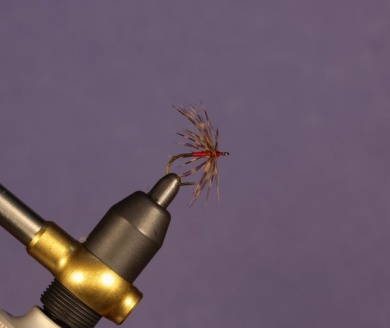There are many different styles of fly tying English flies, one of the more distinct is the one used for flies used in the rapid and structured waters of the northern rivers.The way the hackle is tied, with long soft fibers, and the delicacy of the body barely cover the hook; each material is used a View more...There are many different styles of fly tying English flies, one of the more distinct is the one used for flies used in the rapid and structured waters of the northern rivers.The way the hackle is tied, with long soft fibers, and the delicacy of the body barely cover the hook; each material is used artistically, this is the way of the North Country Spiders. It’s very interesting noticing how an imitation of a family of insects that don’t vary much from conti-nent to continent can produce really different styles of fly tying, to the point that an educated angler can recognize the origin of each fly, maybe even the precise place and tyer. It’s clearly not the same with commercial flies, stereotyped mainly to attract anglers.Impressionist flies like Stewart’s spiders (The Practical Angler 1857) show a great capacity to achieve a subtle delicacy with only the minimum amount of materials, representing effectively the delicate insects, as we can see in this stylized fly from the Scottish highlands.We have to notice that the anglers from the past knew about the capacity of a fly of breaking the water surface, known as Good Entry, making the same action of a natural insect, which makes them especially fit to fish upstream so the hackle acquires its maximum charm and movement.
Move the mouse over the image to zoom in the fly.
Touch the image to zoom in the fly.

List of materials
Hook: Partridge Classic Spider or Daiichi 1110, from 12 to 20 both straight eyed.Thread: Pearsall´s Gossamer, red. Very fine silk thread, traditionally for Spiders. HACKLE: Grouse feather, barred, preferably from the reverse of the wing, or a small one from the back. Try to get one with barred shapes instead of spots, and with a nice curve in the fibers.
Steps
Step 1
Tie the thread to the back, leave some space in the front.
Step 2
Keep tying with tight turns, not until the bend, and then go back evenly to the eye. The body in these spiders don’t surpass the line where the barb is.
Step 3
Choose a grouse feather (length of one and a half hook gap), skin the unnecessary material and tie from the front to the back, as shown in the picture.
Step 4
Trim the remaining quill and continue with the silk to the back.
Step 5
Use separate turns to wrap the grouse to the back. Tie it towards the head. The thread secures the quill without affecting the fibers. These must be almost vertical, with its curve towards the back.
Step 6
Finish with a knot, remember a small head is part of the style of these flies.



